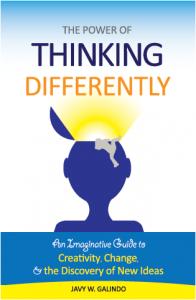Chapter 1 excerpt from The Power of Thinking Differently by Javy W. Galindo
From section entitled “Saved Through Stories” (updated 1/18/09 from draft IIII)
—
Although we can be limited by the stories we habitually tell ourselves, we can also be changed by finding new ones as they open up our view of the field of possibilities. By being able to see the world through the stories of others we can better learn to communicate with those that do not think like us. By expanding the number of stories we tell ourselves of how the world works, we not only have access to new ideas and solutions, but we can deepen the meaning of our own lives.
Through especially humorous stories, we can attain shifts in our perspective that are memorable while also exercising both our faculties of reason and creativity.
It is for these reasons that throughout this book I will reframe my understanding of the creative process using the figurative language of The Island of Pickles and Doughnuts.
**
The villagers of the island were like any other villagers. They had their cooks, their artists, their musicians, their religious, their government officials, their leaders, and their teachers. They had families with children, and parents who tended their daily chores, walking the long trail to work everyday like every other man and woman. For years, the villagers lived their lives as they knew how to live them – how they were taught to live them – proper, normal lives comprised entirely of pickles and doughnuts.
Pickles and doughnuts were all they ate. All their buildings were constructed using only pickles and doughnuts. All their musical instruments were made from only pickles and doughnuts. And pickles and doughnuts were the basis of their religion.
Every evening at supper the children would ask, “Pickles and doughnuts again?” And their mother’s would reply, “What a silly question. Of course we’re having pickles and doughnuts. We always have pickles and doughnuts.” And everyday the children would be dumbfounded, their minds whirling like a dervish, imagining the most unusual concoctions. The children would give these outrageous ideas the most bizarre names – “pan-cakes”, “bread”, “salad”, “sand-which” just to name a few. Who ever heard of such things?
Some lived with an abundance of food, while others struggled to have enough for one meal a day. It all depended on what normal was for them, since everyone lived according to how they had always lived.
As you can imagine, over the years people grew tired of pickles and doughnuts. The cooks wanted new recipes and new ingredients. The writers wanted to write something other than an ode to a pickle, or the mystery of the missing doughnut hole. The merchants wanted something new to sell, and the architects wanted something new to build other than pickle towers and doughnut huts. Over the years, the life of the everyman began to weigh on the everyman; his feet growing tired of walking the same path to work, his hands tired of picking the same pickles, or frying the same doughnuts day after day.
Then, one winter season, the rains and winds were stronger than they had been in a long while. They were so strong that there was major damage to homes, schools, and pickle farms. Rather than the chaos you would expect from such a disaster, the villagers behaved with complete, single-minded conviction. They simply lived each winter day as they had lived all the days preceding it. Though this meant less chaos, this also meant that people had less to eat, lived in ramshackle huts, fell ill more frequently, and grew tired faster than before. The structure of the pickle and doughnut economy remained unaltered, though circumstances obviously dictated the need for some creative change.
Everyone wanted things to be different, but nobody knew how to go about discovering new ideas or new solutions. They simply did what they knew how to do, which is what they always had done.
—
Please leave comments, questions, and suggestions below.


